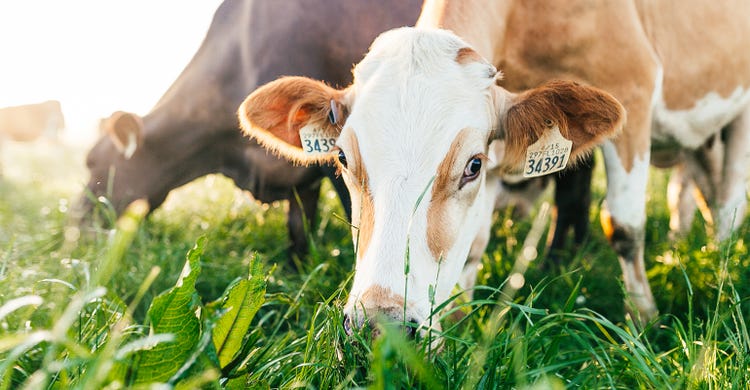California begins groundbreaking effort to define regenerative agriculture
State officials are about to kick off months of listening to industry stakeholders in a move that could affect the movement's future nationwide.

The state of California is in the beginning stages of a months-long campaign to develop a definition for the term regenerative agriculture, an effort that could yield a common way of understanding it, at least among California officials, by the end of the year.
The endeavor seems simple enough: codifying a vague term that is growing increasingly resonant among farmers, environmentalists and natural and organic products brands. But the undertaking promises challenges and potential controversies, as diverse stakeholders in the nation's most agriculturally rich state—its farms generated $54.5 billion in sales in 2021, according to the U.S. Department of Agriculture—do not uniformly agree upon what the definition should include or avoid. And given California's outsized influence in shaping nationwide movements and trends, whatever the state drafts could affect how farmers around the country pursue regenerative agriculture and inform consumer perceptions of the term.
"I think we'll have an interesting rest of the year listening to opinions," said Karen Ross, secretary of the California Department of Food and Agriculture (CDFA). "I'll always look for the most inclusive pathway forward. We are starting with a framework because we want a broad basic popular understanding of what we mean by regenerative agriculture. We felt it was important to have a framework based on what we see out there that would allow some commonality for how it's used in policies or guidelines coming out from sister agencies.
"One thing everybody shares is a commitment that is it has to start with soil health," she added.
State farmers raise 400 different agricultural commodities, all of which come with unique growing practices and traditions. During the coming months of public meetings and discussions, Ross said state officials will be looking to define regenerative agriculture in ways that invite all the state's farmers to participate. A third-party facilitator will help organize and manage the process "to make sure we are hearing the voices and making sure (their views) are captured," Ross said.
Some stakeholders believe any definition of regenerative agriculture should rest on a foundation of organic—a comprehensively defined and regulated term under the U.S.D.A.'s National Organic Program. When asked about standing regenerative agriculture upon the shoulders of organic, Ross said, "One of our pioneering organic leaders in the state said it should not be exclusive to organic. So we will see. I don't want to prejudge the process, but I do want it to be inclusive." She also said she's not certain there will be a state mandate for regenerative certification.

The march toward defining regenerative agriculture began in the fall of 2022, when the California State Board of Food and Agriculture, an advisory board to the governor, began seeking input about the term. The board turned to the CDFA and the Environmental Farming Act Science Advisory Panel for guidance.
The Scientific Advisory Panel reported its findings in May. Among other things, it concluded that an effective regenerative agriculture definition should lead toward:
Positive impacts on California's environmental, social and economic goals, including climate goals.
Measurable and verifiable outcomes.
Context-specific outcomes.
Healthy soil.
With the panel's findings in hand, California officials will begin their public outreach portion of the effort.
Elizabeth Whitlow, executive director of the Regenerative Organic Alliance (ROA), said she is worried about the campaign.
"We have a lot at stake," she said. The 15 members of the California State Board of Food and Agriculture could, for example, conclude that regenerative agriculture could be "outcomes-based," meaning farming techniques such as the use of pesticides would not be banned and organic would not figure into the definition. On the other hand, she said, the board, which advises the governor, could attach regenerative to organic, and say that if farmers are using pesticides, they are destroying soil microbiomes and thus not building healthy soil.
The term regenerative agriculture offers a "huge opportunity for greenwashing" in agriculture, she said. The Regenerative Organic Alliance offers one of several third-party-certified regenerative seals available to farmers and brands.
As the effort to codify regenerative agriculture matures, Rebekah Weber, policy director for California Certified Organic Farmers, will advocate for including organic within the definition.
"We look forward to CDFA's public engagement process and the opportunity to hear directly from producers, particularly organic and regenerative organic producers who meet rigorous and verifiable standards to claim organic and regenerative organic in the marketplace," she said. "The integrity of these terms is integral to their continued success."
One of those farmers, Bryce Lundberg, vice president of agriculture at fourth-generation rice farm Lundberg Family Farms, said he hopes California sets a high bar. The farm already enjoys Regenerative Organic Certified status for some of its rice; by 2027, Lundberg said the company aims to have all of its organic farms reach ROC status. Regenerative Organic Certified, a program of the Regenerative Organic Alliance, sets exacting standards for soil health, animal welfare and social justice matters of brands seeking its seal of approval.
"You have soil building. You have reduced inputs. You have engagement with wildlife and biodiversity," said Lundberg, who sits on the State Board of Food and Agriculture. "And you treat soil as a living thing and not as a medium to grow your crops. You have rotation and cover cropping and all of the elements that regenerate a farm."
Some producers believe farmers who are taking incremental steps toward regenerative agriculture should be able to use the term. But Lundberg disagrees, calling it "too easy."
California organic fruit grower Vernon Peterson, who owns Abundant Harvest Organics, also believes that regenerative without organic lacks effectiveness.
Third-party oversight of practices "restores the original contract," he said.
"Not only are you taking care of the land—we are certifying that," Peterson said. "But the state being involved is going to skew the definition toward the guy with the most money. That's my cynical take on it."
Peterson, who has been farming for nearly 50 years, envisions positives and negatives associated with the move to define regenerative agriculture.
"Anytime you create a government bureaucracy, you have trouble; but without it, regeneration becomes like sustainable and natural and these other weasel words thrown around," he said. "But if you have a government-sanctioned word not built on organic practices, then you are worse off. Then you have something with the state's blessing—and an invalid definition."
Peterson has farmed organically for decades. Ever since incorporating more regenerative practices into his operation, his soil's organic matter has been increasing about 30% year over year. The farm, which has ROC status, now has a negative carbon impact.
"Hopefully what we end up with is built on an organic foundation, and improves soil organic matter," he said. "That's what consumers want. They want agriculture to fix the environment. They want agriculture to pull carbon out of the air. It checks a lot of boxes when you combine regenerative with organic."
Read more about:
OrganicAbout the Author
You May Also Like




.jpg?width=700&auto=webp&quality=80&disable=upscale)